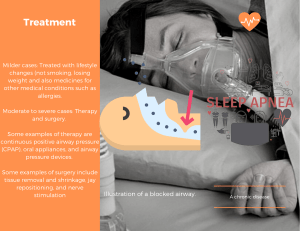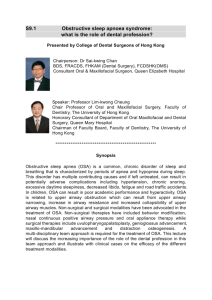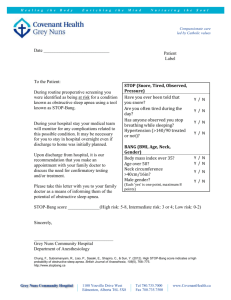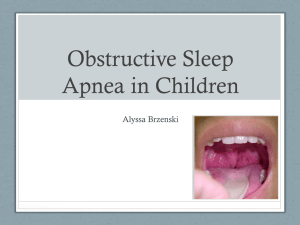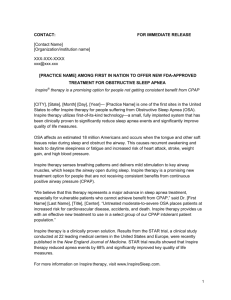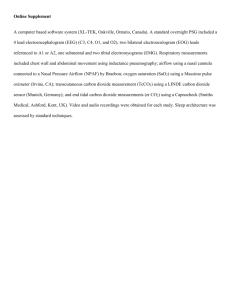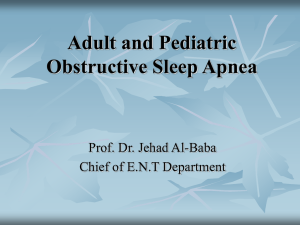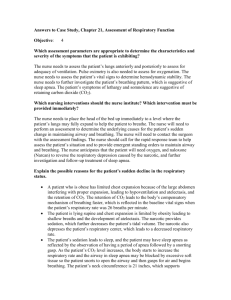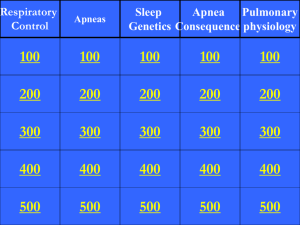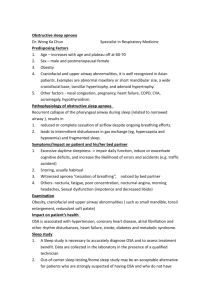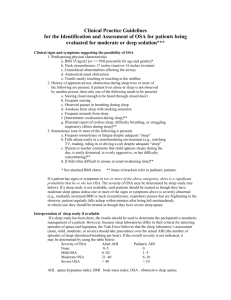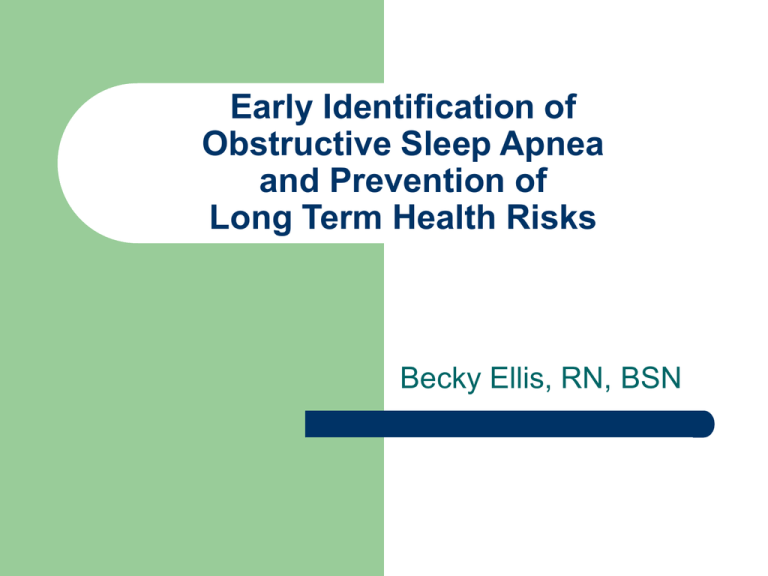
Early Identification of
Obstructive Sleep Apnea
and Prevention of
Long Term Health Risks
Becky Ellis, RN, BSN
Definition
Obstructive Sleep Apnea (OSA) is disordered
breathing during sleep in which the airway is
mechanically obstructed causing a cessation
of breathing.
Left untreated can lead to cardiovascular and
cerebrovascular disease and injury from
vehicular accidents because of sleepiness.
Not everyone who snores has sleep apnea,
but everyone with sleep apnea snores.
Incidence of Obstructive Sleep Apnea
It is estimated that 18 million Americans
suffer from OSA
Found across all age groups, both sexes, all
socioeconomic classes and ethnic groups
Most common in obese middle-aged men
and obese postmenopausal women
Causes
Mechanical obstruction of the airway
–
BMI (body mass index) of 30 or above
–
Excessive tissue in neck area
–
Aging process which causes the neck muscles
loose tone and collapse when lying supine
Unobstructed Airway
www.Sleepapnea.org
Obstructed Airway
www.sleepapnea.org
Pathophysiology
Periods when all breathing ceases for up to
30 seconds or longer causing:
–
–
–
Severe oxygen desaturation
Vasoconstriction and consequent increases in
systemic pressure, increased left ventricular after
load and breathing related changes in cardiac
output
Hypoxemia and retention of CO2 activate the
chemorelfexes and cause arousal from sleep
forcing the person to breathe.
Neurologic Symptoms
Irritability
Depression
Poor judgment
Day time hypersomnia
–
–
Vehicular Accidents
Occupational accidents
Physiologic Complications
Hypertension
Left Ventricular Failure
Ischemic Heart Disease
Severe Sinus Bradycardia
Cerebrovascular Disease
Diagnosis
Overnight Polysomnography
Treatment
Mechanical therapy
–
–
–
–
–
CPAP (most common)
Dental appliances that reposition the lower jaw and the
tongue
Surgery Uvulopalatopharyngoplasty (UPPP) better results
seen in younger patients
Laser-assisted uvulopalatoplasty laser used to remove
excess tissue from back of the throat
Tracheostomy used only in sever life threatening cases
Epidemiological Framework
Web of Causation
–
–
–
Several risk factors (age, sex, and BMI)
Individuals with two or more risk factors will show
an increased predisposition to OSA
Using this framework as the basis for my study
middle aged overweight men and overweight
postmenopausal women are identified as the
group with significant risk
At Risk Population
Middle aged overweight men and overweight
postmenopausal women residing within the
Greater Clark County area.
Further Classification of At Risk
Population
Those with a history of self or spouse
reported snoring
Those with a history of hypertension, LVF,
cardiac arrhythmias and stroke.
Objectives
Widespread public awareness will lead to an
80% increase of newly diagnosed cases of
OSA within Clark County over the next 24
months
With the initiation of early therapy, morbidity
and mortality rates due to related
cardiovascular disease in the at risk
population will be reduced in Clark County by
60% within the next 48 months.
Goals
Increase public awareness of the
seriousness of untreated OSA
Begin immediately to have employer
sponsored classes in the community to
educate the public on recognizing,
preventing and treating OSA
Plan of Action
Begin by educating the health care community
particularly those who provide services to the aging
population within Clark County
Educate the public
–
–
Initiate a massive media campaign using public service
announcements on selected radio and TV stations
Distribute information pamphlets to health clinics,
employers, and senior centers.
References
National Institutes of Health (2003). Facts about sleep apnea.
Retrieved November 22, 2003, www.nih.gov
Shamsuzzman, A. S., Gersh, B. J., & Somers, V. K. (2003, October 8).
Obstructive sleep apnea. Journal of the American Medical Association,
290, 1906. Retrieved November 20, ProQuest
Wolk, R. Kara, T. & Somers, V. K. (2003, July 8). Sleep-disordered
breathing and cardiovascular disease. Circulation, 108, 9-12.
Retrieved November 19, 2003, ProQuest
Young, T. Shahar, E. Nieto, F. J., Redline, S. Newman, A. B., Gottlieb,
D. J., Walsleben, J. A., Finn, L. & Enright, P. (2002, April 22).
Predictors of sleep-disordered breathing in community-dwelling adults.
Archives of Internal Medicine, 162, 893-900. Retrieved November 15,
2003, ProQuest
healthypeople.org. Healthy People 2010. Retrieved November 17,
2003, ProQuest

